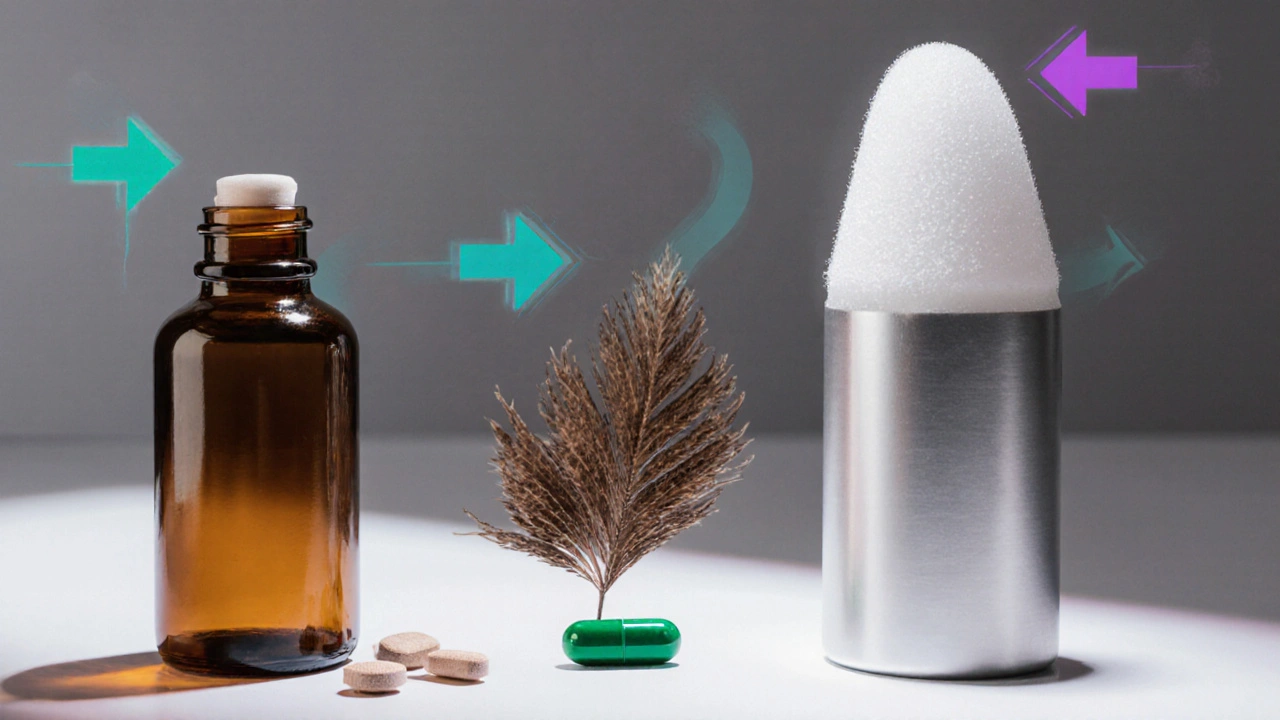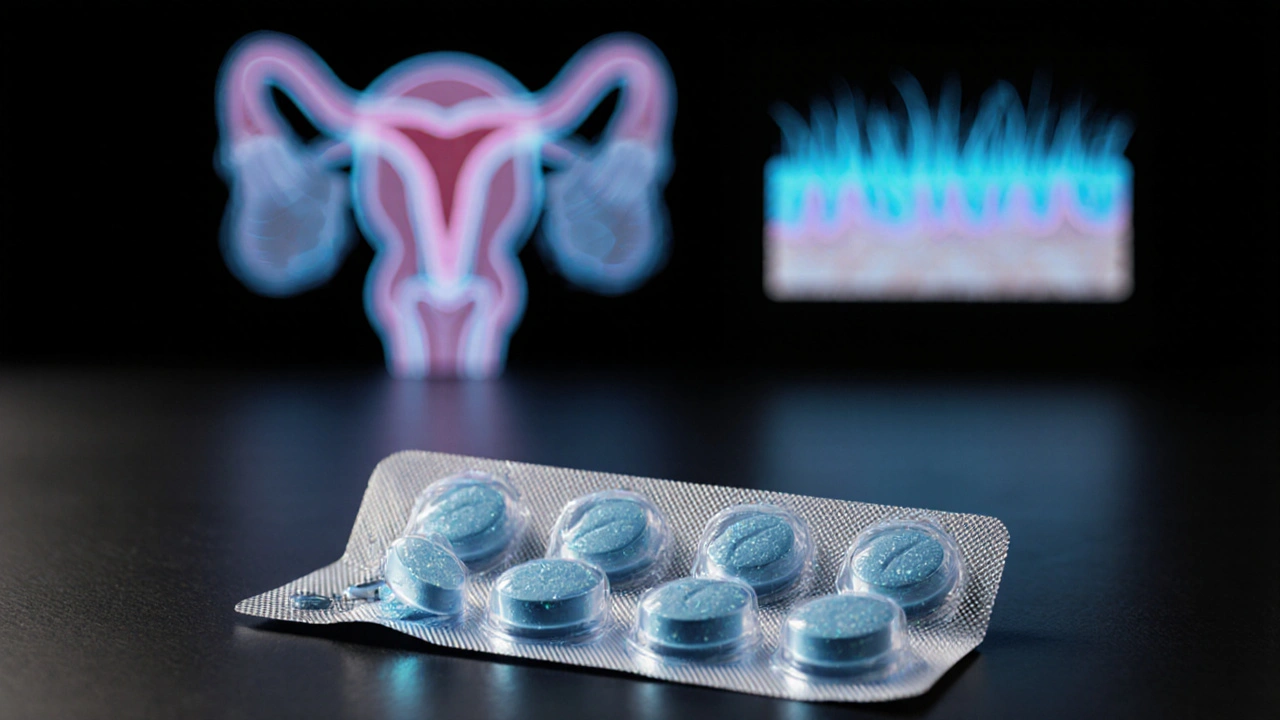Dutasteride vs Alternatives Comparison Tool
Dutasteride
Best for: Prostate Shrinkage
Effectiveness: Up to 90% DHT reduction
Side Effects: Decreased libido, ED, ejaculatory volume reduction
Cost: ~ZAR 400/month
Finasteride
Best for: Hair Loss
Effectiveness: 70% DHT reduction
Side Effects: Lower incidence than Dutasteride
Cost: ~ZAR 150/month
Minoxidil
Best for: Hair Growth
Effectiveness: Vasodilation pathway
Side Effects: Scalp irritation
Cost: ~ZAR 250/month
Saw Palmetto
Best for: Mild Symptoms
Effectiveness: Modest 5α-reductase inhibition
Side Effects: Stomach upset, mild headache
Cost: ~ZAR 200/month
Recommendation:
Based on your selection, Dutasteride is recommended for prostate shrinkage due to its superior DHT reduction. For hair loss, Finasteride is preferred due to its FDA approval and lower sexual side effect risk.
Key Takeaways
- Dutasteride blocks both typeI and typeII 5‑alpha reductase enzymes, making it the most potent option for BPH.
- Finasteride is the go‑to for androgenic alopecia but works only on typeII enzymes.
- Minoxidil treats hair loss through vasodilation, not hormone pathways, and can be combined with oral agents.
- Saw palmetto offers modest prostate relief as a supplement, but evidence is weaker than prescription drugs.
- Choosing the right treatment depends on your primary concern (prostate size vs hair loss), side‑effect tolerance, and cost.
When weighing Dutasteride is a dual 5‑alpha reductase inhibitor used to shrink an enlarged prostate and, off‑label, to slow male pattern hair loss. Its ability to block both typeI and typeII enzymes makes it more powerful than many alternatives, but that potency also brings a unique side‑effect profile. Below we break down how Dutasteride stacks up against the most common rivals, helping you decide which option fits your health goals.
What Is Dutasteride and How Does It Work?
Dutasteride belongs to the class of 5-alpha reductase inhibitors that prevent the conversion of testosterone into dihydrotestosterone (DHT). DHT is the main driver behind prostate growth and hair‑follicle miniaturization. By inhibiting both the typeI enzyme (found in skin and liver) and the typeII enzyme (dominant in the prostate and scalp), Dutasteride reduces DHT levels by up to 90%.
Typical dosing for benign prostatic hyperplasia (BPH) is 0.5mg once daily, taken with or without food. For hair loss, doctors may prescribe the same dose off‑label, though this use is not FDA‑approved in the United States.
Major Alternatives at a Glance
Before we dive into detailed comparisons, here’s a snapshot of the key players you’ll encounter:
- Finasteride - a single‑typeII inhibitor approved for both BPH (5mg) and androgenic alopecia (1mg).
- Minoxidil - a topical vasodilator that promotes hair growth without affecting DHT.
- Saw palmetto - a botanical extract that modestly inhibits 5‑alpha reductase, often sold as a supplement.
- Benign Prostatic Hyperplasia - a non‑cancerous enlargement of the prostate gland, the primary condition Dutasteride treats.
- Androgenic Alopecia - commonly known as male‑pattern baldness, the other major target of DHT‑lowering drugs.

Side‑Effect Profile Comparison
Understanding side effects is crucial because the same hormone pathway underlies both prostate and hair concerns. Below is a side‑by‑side look at the most common adverse events reported in clinical trials and post‑marketing surveillance.
| Drug | Common Side Effects | Serious Risks | Impact on Sexual Function |
|---|---|---|---|
| Dutasteride | Decreased libido, erectile dysfunction, ejaculatory volume reduction | Potential high‑grade prostate cancer detection bias | ≈10% report noticeable changes |
| Finasteride | Similar to Dutasteride but slightly lower incidence | Rare cases of persistent sexual dysfunction after discontinuation (post‑finasteride syndrome) | ≈7% report changes |
| Minoxidil | Scalp irritation, itching, dandruff | Systemic hypotension if over‑absorbed (rare) | None reported |
| Saw Palmetto | Stomach upset, mild headache | Interaction with anticoagulants (theoretical) | None reported |
Effectiveness for BPH and Hair Loss
Clinical data show distinct strengths for each option. For BPH, the Prostate‑Specific Antigen (PSA) level typically drops 20-30% after three months on Dutasteride, correlating with improved urinary flow rates. Finasteride reduces prostate volume by about 15% on average.
When it comes to hair loss, finasteride’s 1mg daily dose reduces scalp DHT by roughly 70%, leading to a 10‑15% increase in hair count over a year. Dutasteride, because of its broader enzyme blockade, can achieve a 30‑40% increase in hair density, but the data are less robust and the drug remains off‑label.
Minoxidil works through a completely different pathway: it widens blood vessels in the scalp, extending the anagen (growth) phase of hair follicles. Studies report a 30‑40% increase in hair count after six months, but the effect stops when treatment ends.
Saw palmetto’s impact on hair is modest; meta‑analyses find a 5‑8% improvement versus placebo, making it a popular adjunct rather than a primary therapy.
Cost Considerations
Affordability often tips the balance. In South Africa, a 30‑day supply of generic Dutasteride costs roughly ZAR400, while generic finasteride is about ZAR150. Minoxidil (5% topical) runs ZAR250 for a month’s supply. Saw palmetto supplements vary widely, averaging ZAR200 for a 60‑capsule bottle.
Insurance coverage typically favours finasteride for BPH because it’s FDA‑approved for that use, whereas Dutasteride may require prior authorization or out‑of‑pocket payment. For hair loss, most patients pay cash for either drug.

Choosing the Right Option for You
- Define your primary goal. If urinary symptoms dominate, Dutasteride’s superior prostate shrinkage makes it a strong candidate. If you’re mainly fighting hair loss, finasteride’s FDA approval and lower sexual‑side‑effect rate often win.
- Assess tolerance for side effects. Men who have experienced erectile dysfunction on finasteride may prefer the lower‑dose Minoxidil + Saw palmetto combo.
- Consider cost and insurance. Out‑of‑pocket budgets favour finasteride for BPH and minoxidil for hair loss.
- Look at drug interactions. Both Dutasteride and finasteride are metabolised by CYP3A4; avoid strong inducers (e.g., rifampin) or inhibitors (e.g., ketoconazole) without medical advice.
- Plan for monitoring. PSA should be tested before starting any 5‑alpha reductase inhibitor and then every 6-12months. For hair treatments, schedule a dermatologist visit at six‑month intervals.
How to Talk to Your Doctor
Bring a concise list of what you’ve learned: drug name, dose, why you think it fits, and any concerns about side effects. Ask specific questions such as:
- Will Dutasteride affect my sexual performance, and how reversible is that?
- Do I need regular PSA checks, and what changes should I report?
- If I combine a topical treatment like Minoxidil with an oral inhibitor, are there any safety issues?
- Are there any supplements I should avoid while on a 5‑alpha reductase inhibitor?
Being prepared shows you’ve done your homework and helps the clinician tailor a plan that matches your lifestyle.
Frequently Asked Questions
Can I use Dutasteride for hair loss if I’m already on Finasteride?
Switching from finasteride to dutasteride is possible, but you should taper off finasteride under a doctor's supervision to avoid overlapping hormone suppression. Some men report better hair density with dutasteride, but the risk of sexual side effects also rises.
Do I need to stop Dutasteride before a prostate biopsy?
Yes. Because dutasteride lowers PSA, doctors usually ask patients to discontinue the drug at least four weeks before a biopsy to avoid false‑negative results.
Is Saw palmetto a safe natural alternative to prescription drugs?
Saw palmetto is generally safe for most people, but its efficacy is modest. It may be useful as a supplement for mild BPH symptoms, yet it shouldn’t replace dutasteride or finasteride for moderate‑to‑severe cases.
How long does it take to see improvement in urinary symptoms with Dutasteride?
Most men notice better flow and fewer nighttime trips after 3-6months of consistent daily dosing, although maximal prostate shrinkage may continue up to a year.
Can I use Minoxidil and Dutasteride together?
Yes, the two drugs act on different pathways and are often combined for best hair‑loss results. Just follow the recommended application for minoxidil and take dutasteride as prescribed.

Comments (12)
April Conley
October 7, 2025 AT 17:12
Dutasteride beats finasteride for prostate shrinkage.
Sophie Rabey
October 9, 2025 AT 02:32
Sure, the DHT‑centric jargon is fascinating: dutasteride slashes DHT by up to ninety percent, while finasteride settles for a modest seventy, all while the side‑effect profile dances around libido and ejaculatory volume. It's almost as if the pharma board decided to sell potency at a premium and call it progress. Yet the FDA still nudges us towards finasteride for hair because, you know, labs love clean labels.
Bruce Heintz
October 10, 2025 AT 14:38
Exactly, Sophie – the trade‑off is real 😊. If you can tolerate a slight dip in libido, dutasteride’s prostate‑shrinkage is impressive, but for many the safer odds of finasteride win the day. Plus, coupling minoxidil on the scalp can soften the hair‑loss curve without upping DHT worries.
richard king
October 11, 2025 AT 21:13
Behold the grand theatre of hormones, where dutasteride swoops in like a merciless knight, laying waste to both type I and type II 5‑alpha reductases, whilst its humble cousin finasteride merely tips its hat to the latter. In this arena, the stakes are not just swollen prostates but the very essence of masculinity, a drama of DHT and desire that would make even the most stoic philosophers gasp.
Dalton Hackett
October 13, 2025 AT 05:12
The comparison between dutasteride and its alternatives is nuanced and warrants a thorough examination.
First, dutasteride’s dual inhibition of type I and type II 5‑alpha reductase results in a markedly higher reduction of systemic DHT relative to finasteride, which targets only type II.
This pharmacodynamic profile translates into superior prostate volume shrinkage in clinical trials, often exceeding a 20‑30% reduction in PSA levels after six months of therapy.
However, the same potency is responsible for a higher incidence of sexual side effects, including decreased libido and ejaculatory dysfunction, which some patients find unacceptable.
Finasteride, while less potent, offers a more favorable side‑effect balance and enjoys FDA approval for both BPH and androgenic alopecia.
Minoxidil operates via a completely different vasodilatory mechanism and does not interfere with androgen pathways, making it a safe adjunct for hair regrowth but ineffective for prostate issues.
Saw palmetto, as a phytotherapeutic agent, provides modest 5‑alpha reductase inhibition but suffers from variable bioavailability and limited high‑quality evidence.
Cost considerations also play a role; dutasteride’s monthly price in South Africa approximates ZAR400, whereas generic finasteride can be obtained for roughly ZAR150.
Insurance coverage typically favors finasteride for BPH, relegating dutasteride to a prior‑authorization scenario that can delay treatment initiation.
From a monitoring perspective, any patient started on a 5‑alpha reductase inhibitor should have a baseline PSA level and subsequent testing every six to twelve months to assess therapeutic response and detect any potential malignant transformation.
It is also prudent to counsel patients about the potential for persistent post‑finasteride syndrome, a rare but reported phenomenon of ongoing sexual dysfunction after cessation of therapy.
When combining oral agents with topical minoxidil, clinicians should reassure patients that systemic absorption of minoxidil is negligible, thus minimizing drug‑drug interaction risk.
In practice, many urologists adopt a stepwise approach, beginning with finasteride for mild‑to‑moderate BPH and reserving dutasteride for cases refractory to initial therapy.
The decision matrix should incorporate the patient’s symptom severity, side‑effect tolerance, comorbidities, and financial constraints.
Ultimately, personalized medicine-balancing efficacy, safety, and cost-remains the cornerstone of optimal management for both prostate enlargement and androgenic alopecia.
William Lawrence
October 14, 2025 AT 14:32
Oh great another "miracle" drug you can only get after jumping through hoops. The side effect list reads like a horror movie and you still get told it’s the best option if you can afford it.
Grace Shaw
October 16, 2025 AT 02:38
While the preceding remarks offer valuable insights, it is essential to approach this therapeutic decision with a measured degree of decorum. The comparative efficacy of dutasteride versus finasteride is well-documented, yet the nuanced differences in adverse‑event profiles warrant a thorough discussion with the patient. Moreover, considerations of cost, insurance coverage, and individual tolerance should be integrated into a shared‑decision‑making model. In sum, the clinician must balance pharmacologic potency with the holistic well‑being of the individual.
Sean Powell
October 17, 2025 AT 17:32
Grace you nailed it, thanks for the clear breakdown. just remember to check for any possible drug interactions especially if folks are also on blood thinners – saw palmetto can be a bit tricky there.
Henry Clay
October 19, 2025 AT 11:12
Wow, thanks for the thoroughness 🙄. Honestly, most patients don’t read the fine print and just want something that works – the pharma spiel is just noise.
Isha Khullar
October 21, 2025 AT 07:38
In the grand tapestry of medical choices, dutasteride stands as a dark star, its power both blessing and curse, a paradox that mirrors the human condition.
Lila Tyas
October 23, 2025 AT 06:52
Love that poetic vibe, Isha! If you’re considering dutasteride, just keep an eye on any changes in energy or mood – staying proactive helps you ride the wave smoothly.
Mark Szwarc
October 25, 2025 AT 08:52
From a pharmacological standpoint, the key distinction lies in enzyme selectivity: dutasteride inhibits both type I and II 5‑alpha reductase, achieving roughly 90% DHT suppression, while finasteride targets only type II with about 70% reduction. This translates to greater prostate volume reduction but also a higher frequency of sexual side effects. Clinicians should initiate therapy after baseline PSA measurement, monitor PSA every 6‑12 months, and discuss potential post‑finasteride syndrome even though it’s rarer with dutasteride. Combination therapy with topical minoxidil remains safe and can enhance hair regrowth outcomes. Cost‑effectiveness analyses generally favor finasteride for BPH in health‑system settings, whereas dutasteride may be justified for refractory cases or where maximal DHT suppression is desired.